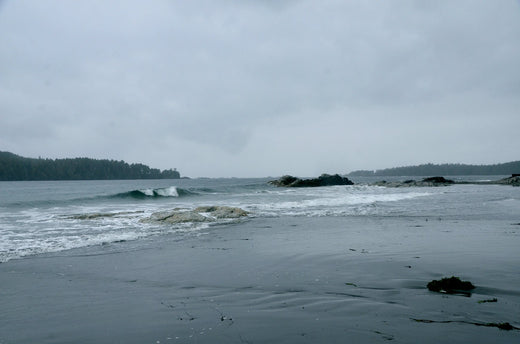
A Profound Journey into Ancestral Landscapes
Share
The month of November marked a deeply personal and transformative chapter in my project as I visited two locations of immense ancestral significance: Morpheus Island near Meares Island and Stubbs Island, now known as Clayoquot Island. These visits were not only poignant but also central to reconnecting with my family’s history and legacy on the west coast.

Visiting Morpheus Island: Honouring My Great-Grandparents
Our morning began with a visit to Morpheus Island, the burial site of my great-grandparents. This site has been a resting place for our family since pre-war times, before burials in that area transitioned to the Tofino Graveyard. The last time I visited this sacred place, I was ten years old. It was a year after my grandfather passed away, and we had scattered some of his ashes at the headstone of his parents. I vividly remember how the family gathered to clean and tend to the graveyard during that visit—a tradition of care and reverence.
Returning now as an adult, I was struck by how well the burial ground had been preserved. Someone had clearly been maintaining it, ensuring its historical and familial significance was respected. However, I also plan to return and contribute to the upkeep, attending to the maintenance and gardening of our family plot. The experience of standing there again, reflecting on the continuum of generations, was deeply moving and reaffirmed my commitment to this project.
 Morpheus Island 1986 Morpheus Island 1986 |
 Morpheus Island 2024 Morpheus Island 2024 |

Exploring Clayoquot Island: A Rare Privilege
The second part of my journey took me to Stubbs Island, now known as Clayoquot Island. Accessing the island required special permission, as it is no longer open to the public. Thanks to my family’s historical connection, I was granted the opportunity to visit—a privilege that brought immense emotional weight and significance.
Standing on the island where my great-grandfather’s family settled in 1917 after immigrating from Japan, I felt an unparalleled sense of connection. It was the first time I had set foot on this land, yet it resonated deeply as part of my heritage.


Discovering the Island's Beauty and History
What surprised me most about Clayoquot Island was its breathtaking beauty and lush vegetation. The island is home to a garden nearly unmatched on the coast, featuring towering rhododendrons—some of which must be over 150 years old. These ancient plants, alongside majestic trees, shrubs, and vibrant flowers, created an almost timeless atmosphere.
We explored various regions of the island, each offering its own unique charm. A stunning boardwalk led us from the garden to the southernmost beach, revealing the island’s diverse and thriving ecosystems.
The historical significance was palpable as we visited the site of the former Japanese Canadian village. While much of it is now overgrown, the land itself bears silent testimony to the lives once lived there. The contours of the landscape suggest where dwellings stood, echoing the resilience and community of my ancestors.
 |
 |
A Profound Sense of Belonging
As we made our way back to the boat, I was overwhelmed by a profound sense of belonging. Walking the same land where my ancestors built their lives, I felt an unbroken connection to their legacy. The experience deepened my understanding of the enduring ties between place, memory, and identity. I recalled my Grandmother telling me, that Grandpa Tommy always used to say they wouldn’t have made it through a winter on Stubbs Island if it wasn’t for the First Nations.
This visit to Morpheus and Clayoquot Islands was a defining moment in my journey, both personally and creatively. It reminded me of the strength and perseverance of my ancestors and the importance of preserving these stories and places for future generations. As I continue to work on The Missing Link, these experiences will remain a cornerstone of the project, infusing my art with the depth and richness of our family’s history.
